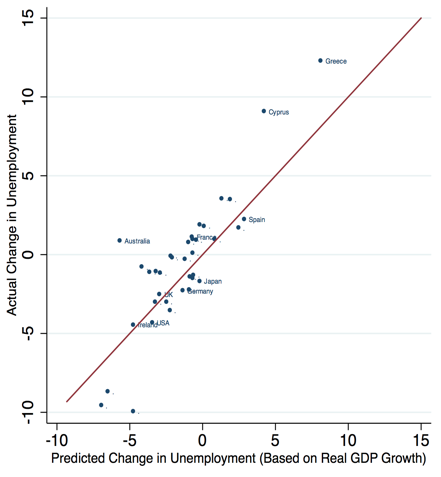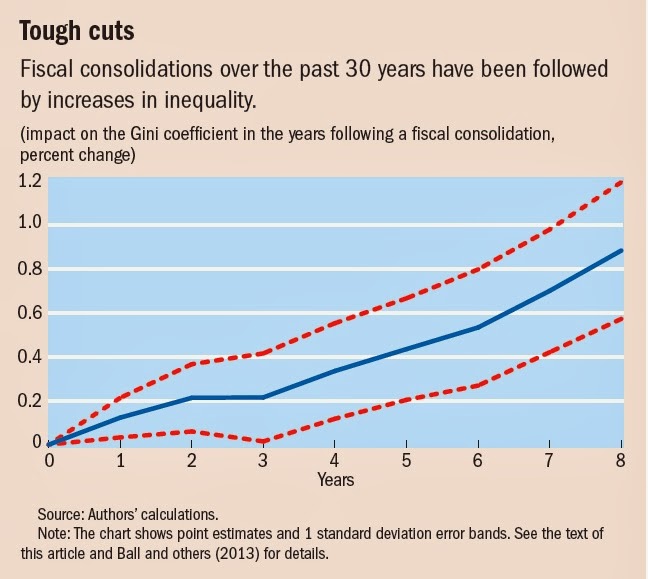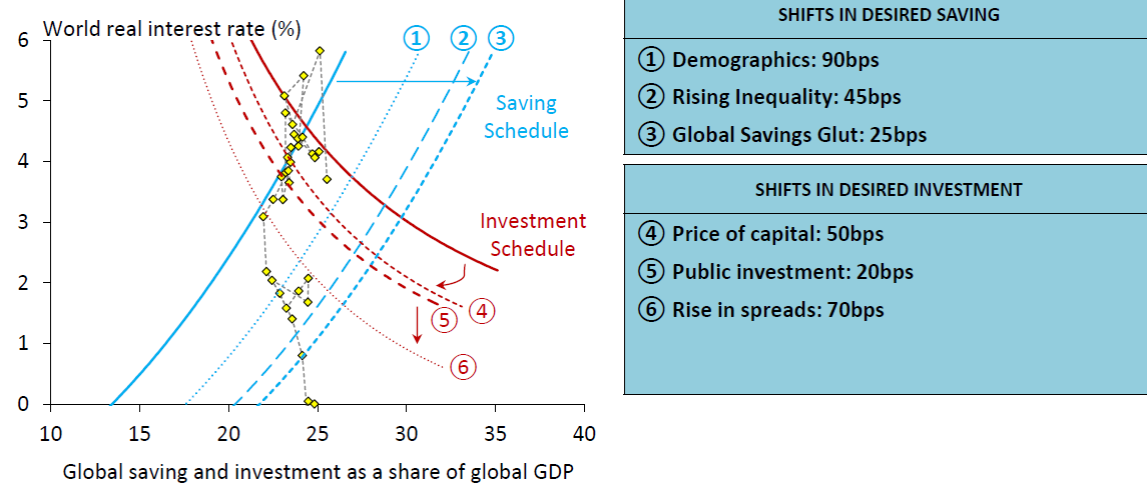Tuesday, December 6, 2016
Austerity and Inequality: New Evidence from the IMF
The IMF Economic Review just published a paper that looks into the “distributional consequences of fiscal austerity measures” for 17 OECD countries over the last 30 years. This new paper adds to the stock of IMF papers on the impacts of fiscal consolidation of inequality. Here are links and a cheat sheet to the key papers:
1) Painful Medicine: This (non-wonkish) paper documented that fiscal consolidations not only lower aggregate incomes but have distributional consequences—wage incomes fall more than profits; and the long-term unemployed are affected more than short-term unemployed.
2) The Distributional Effects of Fiscal Consolidation: A wonkish version of the “Painful Medicine” article, with the additional result that, between 1978 and 2009, fiscal consolidations in advanced economies increased the Gini measure on income inequality.
3) Distributional Consequences of Fiscal Consolidation and the Role of Fiscal Policy: In addition to confirming the results in the previous papers, this paper brings in evidence from emerging markets. It also discusses how policies can be designed to mitigate the impacts of fiscal policy on inequality.
4) Who Let the Gini Out?: A (non-wonkish) summary of some of the previous papers.
5) Fiscal Policy and Inequality: A key finding of the paper is that fiscal consolidations during the Great Recession did not lead to increases in inequality.
6) Distributional Consequences of Fiscal Adjustments: What Do the Data Say?: “The paper shows that fiscal adjustments are likely to raise inequality through various channels including their effects on unemployment. Spending-based adjustments tend to worsen inequality more significantly, relative to tax-based adjustments. The composition of austerity measures also matters: progressive taxation and targeted social benefits and subsidies introduced in the context of a broader decline in spending can help offset some of the adverse distributional impact of fiscal adjustments.”
The IMF Economic Review just published a paper that looks into the “distributional consequences of fiscal austerity measures” for 17 OECD countries over the last 30 years. This new paper adds to the stock of IMF papers on the impacts of fiscal consolidation of inequality. Here are links and a cheat sheet to the key papers:
1) Painful Medicine: This (non-wonkish) paper documented that fiscal consolidations not only lower aggregate incomes but have distributional consequences—wage incomes fall more than profits;
Posted by at 10:22 AM
Labels: Inclusive Growth
Sunday, December 4, 2016
European Unemployment: Deja Vu All Over Again?
Thirty years ago, a distinguished group of economists advocated a ‘two-handed’ approach to unemployment that targeted supply as much as demand. This column examines recent work on the effectiveness of cyclical and structural policies – the two ‘hands’ – targeting unemployment in Europe. It further considers the pressures from greater integration of capital and labour markets on the success of these reforms. Cyclical measures, particularly the easing of monetary policy, have been successful, but further structural reforms are still needed in many countries where average unemployment remains too high.
Read the rest at Vox.
Figure 1. Actual and predicted changes in unemployment, advanced economies, 2010 to 2015

Notes: The chart compares the actual change in unemployment in each country with what could have been predicted on the basis of the hisotrical relationship between unemployment and output (Okun’s Law).
Thirty years ago, a distinguished group of economists advocated a ‘two-handed’ approach to unemployment that targeted supply as much as demand. This column examines recent work on the effectiveness of cyclical and structural policies – the two ‘hands’ – targeting unemployment in Europe. It further considers the pressures from greater integration of capital and labour markets on the success of these reforms. Cyclical measures, particularly the easing of monetary policy, have been successful, but further structural reforms are still needed in many countries where average unemployment remains too high.
Posted by at 10:45 PM
Labels: Inclusive Growth
Will Interest Rates Stay Low?
Jim Hamilton offers a characteristically clear summary of a Bank of England paper on the factors affecting global saving and investment and hence global real interest rates. It is a good example of how economists use supply and demand to analyze current developments.
http://econbrowser.com/archives/2016/12/factors-in-low-real-interest-rates
Jim Hamilton offers a characteristically clear summary of a Bank of England paper on the factors affecting global saving and investment and hence global real interest rates. It is a good example of how economists use supply and demand to analyze current developments.
http://econbrowser.com/archives/2016/12/factors-in-low-real-interest-rates
Posted by at 7:02 AM
Labels: Macro Demystified
Subscribe to: Posts





